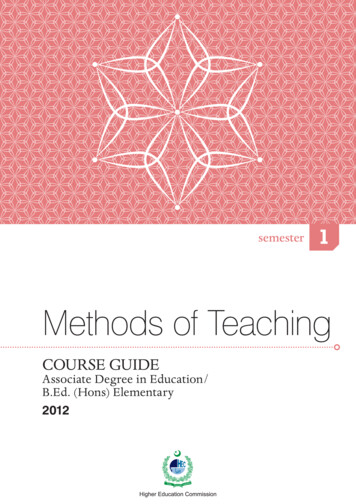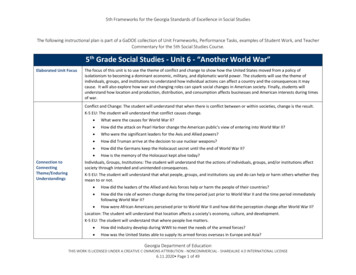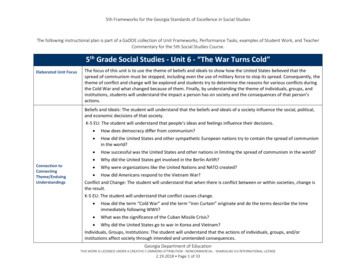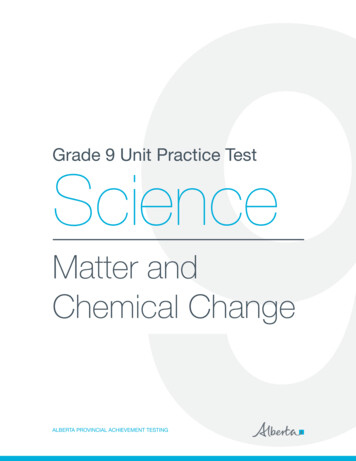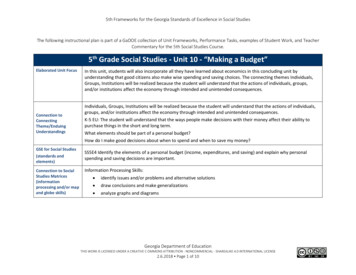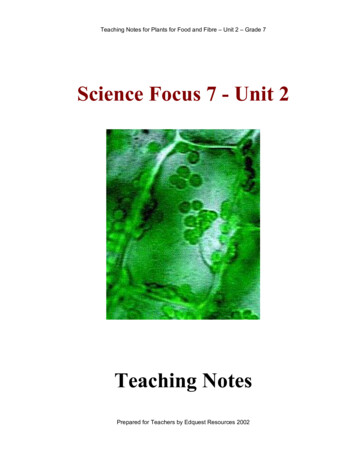
Transcription
Teaching Notes for Plants for Food and Fibre – Unit 2 – Grade 7Science Focus 7 - Unit 2Teaching NotesPrepared for Teachers by Edquest Resources 2002
Topic 1 - People and PlantsPeople use plants for things other than food. Plants also provide fibre, which is the tissueof plants from the stem, leaves, seeds or roots. The subtopics will outline how plantsfrovide food and fibre for human needs.Plants in the EnvironmentAs a critical part of the ecosystem, plants provide oxygen for organisms to survive. Theyare able to reduce the problem of pollution, by using carbon dioxide. Plants are also thebasis of most food webs as producers of food for herbivores and ultimately carnivores.Plants also provide shelter for animals, clean and filter water and help prevent soilerosion.Plants for FoodNearly 75% of the world's food supply is based on seven major crops: wheat, rice, maize(corn), potatoes, barley, cassava and sorghum.From Plant to Final Product (p. 93)CocoaCanolaSeeweedSugarChocolate is madefrom the fruit of thecocoa tree78% of vegetable oilproduction is fromcanolacontains iodine and isused in soup brothsand sushihalf of the world'ssugar comes fromsugar beets, located inthe sugar beets' rootsother products fromCanola is pressed from seeweed include: iceCocoa beans arethe canola seeds and cream, chocolate milk,roots are shredded,roasted, shelled andused as salad oil and yogurt, whipped cream, heated in running waterthen crushed. Cocoafrying oilpies, jellies andand the concentratedbutter and cocoacandiesclear liquid crystallizespowder are separated.Cocoa powder is thento produce sugarIt is used to makeseeweed products aresimilar to sugar canemixed with milk tomargarine, shortening, often used to thickenmake chocolate.baked goods, potatofood (alginate, agar,chips and french friescarrageenan)
Plants for FibrePlants provide fibres for clothing, paper and shelter. The aboriginal people from the westcoast wove cloth from the bark of the western red cedar tree. Much of our clothing todaycomes from synthetic (manufactured) material, such as polyester and nylon. Natural fibresalso provide resources for cloth:Cotton- is a natural fibre that absorbsmoisture and then allows it toevaporate easily, making it theworld's most important nonedible plant. The cotton fibrescome from the plant's seeds.The silky fibres are strong,flexible and have a gradualspiral that causes the strands tointerlock when twisted, makingthem ideal for spinning intothread. The second layer offibers are shorter and are 'fuzzy'- they are used to make cottonbatting, rayon and various typesof plastic and paper.Hemp- early makers of jeansused hemp, which is theoldest cultivated fibre plantin the world. Otherproducts included theBible, sails and ropes.Hemp has a less negativeeffect on the environment,because it uses less landarea than trees, can beharvested in a year, lastslonger than paper, can berecycled up to seven times,chokes out weeds naturallyand is not prone to insectpests.Flax- is a food and fibre crop.The flax fibres, which aresmooth and straight, aretaken from the stem ofthe plant are are two tothree times stronger thancotton fibres. Flax fibreis used for making linenpaper, linseed oil - whichis used as a drying oil inpaints and varnish - andin products such aslinoleum and printinginks.Plants for MedicineAn apple a day keeps the doctor away! Many medicines (over 7000) contain ingredientsmade from plants. Herbal remedies are a common example of how plants are used toprevent illness. Plant medicines include: tea (made from ginger root) - is used to soothe anupset stomach; white willow bark - is used to ease pain; opium poppy seed pod - thickmilky fluid provides a powerful pain medication – morphine; codeine is also found in thepoppy - it is used in cough medicines; quinine - which comes from the cinchona tree - isused to prevent malaria.Plants for Transportation and ConstructionRubber is one of the most important plant products that people use. Natural rubber comesfrom the Brazilian rubber tree. Synthetic rubber is made from coal and oil by-products but natural rubber is also an important ingredient.Canoes were carved from trees by Aboriginal people. Lubricants are provided fromcoconut and castor bean oils. The construction industry in North America uses wood(softwood lumber from British Columbia) as a building material.Plants for FuelWood or coal (which is a fossil fuel) are used to heat homes. Sugar can be turned intoethanol and wood can provide methanol (wood alcohol). Fuel from plants is economical,but not energy efficient, because a large amount of energy is need to grow the plants anda lot of the energy is lost when it is converted to fuel.Human Needs and Plant NeedsOur task is to make sure that plants survive and thrive in order to have this importantresource in the future.Topic 1 Review p. 103
Topic 2 - Structure and AdaptationsPlants have particular habitats, each with its own set of environmental characteristics,including light, temperature water and soil conditions. The structure of a plant helps it toadapt to these conditions.RootsThere is much more to a plant than what you are able to see above the surface of the soil.In fact, up to one third of the plant can be beneath the soil. Types of RootsRoots perform several functions: they absorb water and minerals from the soil they support and anchor the plant so it cannot be relocated easily they store food to help the plant survive during times of scarcityThe most prominent part of the root in many plants isthe taproot, with many smaller roots coming out fromit, like branches on a tree. These smaller roots arecovered in root hairs. The smaller roots and roothairs absorb water and nutrients from the soil.Other plants have fibrousroots, which is a shallowsystem of similar-sizedroots that can quicklysoak up moisture.Roots are often especially adapted to a plant's habitat.Moss campion is an example of how a plantgrows its taproot system throughout the earlyyears of the plant's life, so that it can have a wellestablished taproot system before the upperpart of the plant matures (it can take up to 25years for the plant to bloom).ROOT CROPSGenerally grow in a short periodof time, usually survive whenthere is little moisture and canbe stored for long periods oftimeThe duckweed on theother hand has tinyroots on the undersideof the leaf and aresurrounded entirely bywater.
Diffusion and Osmosis (p. 107)Diffusion is the tendancy of particles in a gas or liquid tobecome evenly distributed by moving from areas of greaterconcentration to areas of lesser concentration. The particlescontinue to spread out until they are evenly distributedwithin the enclosed area.Osmosis is a particular type of diffusion in which only someof the particles are allowed to pass through a barrier. Thisbarrier is called a differentially permeable membrane.Osmosis is the diffusion of water through a differentiallypermeable membrane.StemsOne function of the stem isto transport water andnutrients between the leavesand the roots.SupportAnother function of thestem is to support theleaves and to ensure thatthe leaves receive adequatelight. To achieve this moststems grow above thegroundFood StorageAnother function of the stemis to store food for the plant.The food produced in theleaves is stored ion the stem- like potatoes, which haveswollen underground stemscalled tubers (the starchthey store is used by theplant to grow). Some plantsstore food as sugar as well the sugar cane is a goodexample.Different Types of StemsStrawberry RunnersGladioli CormCattails Horizontal RhizomesCacti Fattened Stems
LeavesA pigment called chlorophyll makes the leaves green.The energy of the sun is trapped in the leaves andchanged into a kind of chemical energy. Carbondioxide and water are used by the leaves in theprocess called photosynthesis, to make sugar andgive off oxygen. Plants also need oxygen - at nightwhen photosynthesis does not happen, respirationdoes. Respiration is a process by which plantsrelease carbon dioxide and let oxygen into their cells.Water enters and leaves the cells in the leavesthrough the guard cells. When they absorb water theyswell, opening the stoma (which lets in carbondioxide and lets out water vapor). The loss of waterthrough evaporation is called transpiration.Moving Water in PlantsThe pushing and pulling action of osmosis (pushing water up from the roots) andtranspiration (pulling the water up the xylem tissue from the roots) moves water up to thevery top of the plant.Topic 2 Review p. 114
Topic 3 - Plant Reproduction and BreedingSelective breeding means that people choose specific plants with particularcharacteristics and encourage these plants to reproduce.Apple VarietiesDid You Know (p.116)There are over 7500 varietiesof apples grown in the world of which 2500 are grown inNorth AmericaPlants are also bred for their ability to withstand certain environmental conditions (hardiness) how much food they produce (yield) their resistance to disease. their appearance (sweetheart cherries - Summerland Research Station, B.C.)New Genes?Canola was developed using selective breeding and originated from aplant called rapeseed. It was developed to produce seeds that created agood-tasting oil. Canola crops are now more resistant to diseases, droughtand even certain chemicals.Scientists can change plants by going inside an individual plant cell and modify some ofits material, by removing parts of the cell that control particular characteristics. Thisgenetic material ( genes of the plant ) can then be combined with genetic material fromanother plant to create a new plant - having characteristics from both plants. This process(biotechnology) is called genetic modification, or genetic engineering.Types of Plant ReproductionPlants can reproduce in two very different ways. Sexual reproduction involves theproduction of seeds and fruits from specialized cells of two plants. Asexual, or vegetativereproduction, occurs when a 'parent' plant grows new plants from its roots, stems, orleaves.Traditional types of vegetative reproduction include: cuttings layering (runners) grafting fragmentation (buds and root systems) Seed Plant Reproduction (p. 93)In vegetative reproduction, plants produce new plants identical to themselves. In sexualreproduction - reproduction using seeds - the new plants are slightly different from theirparents.
ConesThe cone is the part of the tree that has a series of woody scales, and come in variousshapes and sizes. Cone-bearing trees produce both male and female cones. Female conescontain ovules (eggs) - the small bumps at the end of a scale in a cone. Pollen grains(containing sperm) develop on the smaller male cone. Wind carries the pollen grains to thefemale cones. Although most of the pollen grains never reach the female cones, those thatdo get caught in the sticky fluid near the ovule. A pollen tube grows to the ovule andsperm is able to fertilize the egg. The process of pollination is complete. Female cones ofpine trees mature, open, and release their seeds during the fall or winter months. (Thiswhole process takes at least two years) The seeds can then be dispersed by variousmethods and when they get covered they can eventually sprout and become new pinetrees.FlowersFlowers use color, scent, nectar to attract animals, so that the pollination processcan begin.Flowering Plant ReproductionFlower Structure - A Web QuestParts of a FlowerIdentify the Flower PartsFlower partFunctionpetalbrightly colored parts of the flower toattract insects and birdssepalgreen, protect the flower before it opens(underneath after it opens)stamen (male reproductive organ)antherpollen grainsfilamentwhere pollen is produced and storedcases containing male reproductive cellsstalk that supports the antherpistil (female reproductive organ)stigmasticky 'lip' of the pistil that capturespollen grainsstylestalk that supports the stigmaovaryswollen base of the pistil containingovulesovulessacs containing female reproductivecellsPollination (good visual description lination.htm )Pollination can occur by self-pollination or cross-pollination.
spreads pollen over more crops than any other insect. ArtificialThe beepollination can also be used to breed different varieties of plants for specific purposes(usually to produce a better yield, or one that is more resistant to environmentalconditions - such as cold winters) It is not just exposure to cold temperatures that killsseeds, but prolonged exposure to cold temperatures.From Seed to FruitOnce a plant is pollinated, a seed is formed. Seed Parts include the living plant (embryo)and the food supply (cotyledon). The length of time a seed is able to stay alive variesaccording to the conditions it experiences. The longest-lasting seed was frozen for over10,000 years before it sprouted and even flowered (p.125).FruitA fruit is the growing ovary of the plant that swells and protects the developing seeds of aplant, until they are ripe. Not all fruits can be eaten though - a cotton boll is a fruit. (usesfor non-edible fruits)Seed DispersalDispersal is the transportation of seeds away from the parent plant.It can happen in various ways (see pictures on p. 127), including: wind waterways (rivers, streams, etc.) bird droppings animal fur fireSpreading and Harvesting Seeds in the FieldFarmers use machines to disperse seeds. Once they have grown into the crop, they areharvested in two steps. A swather cuts the plants and lays them in rows (the stubble what is left of the plant after being cut - prevents the plant from touching the soil, so theseeds can ripen). A combine then separates the grain from the rest of the plant. (The grainseeds are collected and the straw is baled, or spread evenly over the field).GerminationWhen the seed is able to come in contact and get covered by the soil, it remains inactiveuntil the right conditions are present for it to germinate. Germination is the development ofa seed into a new plant. (Figure 2.39 p. 128 - Germination of a bean seed) .Topic 1 Review p. 130Wrap-Up (Topics 1-3) p. 131
Topic 4 - Meeting the Need for Food and FibreBecause we grow more than we consume, Canada exports the excess to other countriesaround the world. Canada is also a leader in forestry and agricultural research science.Scientists, farmers and foresters are working together, developing practices that willreduce the negative effects that sometimes occur when we harvest plants for food andfibre. Sustainability (an ecological balance) is essential if we are to keep our naturalresources healthy in the long term.Agriculture in AlbertaAgriculture is important, but relatively new as an industry in Alberta. Thevast natural resources in Alberta attracted many settlers who cultivatedthe grasslands to grow crops and harvested trees for construction,manufacturing and fuel. Nearly all of the grassland in the prairieprovinces was converted to cropland, thus destroying the naturalvegetation and native plant species that had been around for a thousandyears.This map shows the ecoregions of Alberta where parkland, grassland and Click on Mapforests in Alberta have been cultivated to grow cropsto see full view(Of the 60 million hectares of land in Alberta, over 20 million is nowfarmland. )Who's Who in Crop Country?Alberta crops are worth almost 3 Billion. The food industry is second only to oil and gasin terms of earnings.WheatOatsCanolaBarleyWheat is used tomake food. Theseeds are ground tomake bread, pastaand many otherprocessed foods.Oats are grown tofeed livestock.Oil is pressed out ofthe canola seeds andis used to makemargarine, cookingoil and saladdressing.Is fed to livestockand is used formaking maltflavouring (used inmany foods).Leftover 'meal' isused to feed poultryand livestock,because it is high inprotein.LegumesPotatoesAlfalfaSpecialty CropsThis crop is grownHigh in protein SunflowersThe cool climate isfor its leaves andlegume crops, suchBeans, field corn,ideal for growingstems. They areas field peas, faba (or potatoes. Half of thesugar beets, lentils,known as hay crops safflower and spicesfava) beans andpotatoes grown inor forage crops andlentils are grown in(grown in SouthernAlberta areare fed to livestock. Itthe Parkland andAlberta)processed intoPeace River Regionsfrozen french fries has a very strong anddeep taproot system.and potato chips.Many potatoes aresold to other farmersas seed potatoes.Math Note: A hectare of land is equal to 10,000 square meters of land.
Growing Under GlassThe yield from crops that are grown outdoors is highly dependent on the environmentalconditions, climate and soil types. In a greenhouse all of the growinging conditions can becontrolled. There are obvious advantages, but there are also disadvantages. Make a list ofthose you are able to find out about and report your findings to the class to complete thechart.AdvantagesDisadvantageshigher yieldcostA wide range of warm-season crops, including seedless cucumbers, tomatoes, lettuce,peppers, house plants, and cut flowers grown in greenhousesFarming PracticesTo be economically sustainable, farmers need to make more money with their crops thanthey spend to grow their crops. They are able to do this by using very large machinery thatcan cover large parcels of land as they seed and harvest their crops. They also need toadd fertilizer to the soil to increase the yield and irrigate to provide the need moisture forgrowth of the crop. Most farmers only grow one type of crop in one particular area - this isknown as monoculture.Farming Then and NowFarming practices changed from using human and animal power in the early 1900's to totalmechanization by the 1950's to modern computerized controls in the present. Comparisonchart on p. 141.Farming ActivityTechnology of the Early1900'sTechnology of Todayloosen the soiloxen or horse-drawncultivatorcultivator machinesadd nutrientsmanure used as fertilizerchemical fertilizersfungi (disease) controlfew controls for fungichemical fungi controlspreading seed evenlyseeds spread by handair seeders and seed drillspest and weed controlpeople, including children,pulled weeds by handsprayed with chemicalscutting of grainscythe used to cut cropsswathers used to cut haythreshing of graingrain picked by hand (tossedcombines used to harvestin the air and caught in agrain and separate seeds andbasket - wind carried thehaystraw away)taking crop to markethorse-drawn cartslarge tractor trailer trucksprepare land for anotherseasonhorse-drawn ploughmodern plough
Saving Soil MoistureIrrigation is a technique that farmers use to make sure that moisture gets into the soil forcrop growth. It is often a problem in grassland areas, where the moisture evaporatedquickly. Irrigation systems (using natural waterways and irrigation canals) can often be thelife or death of a crop and must be maintained, to ensure an adequate supply of water isavailable when it is needed.Fibre Plants and the Forestry IndustryCanada has about 10% of the world's forests. From these forests come lumber and pulpand paper products. Natural forests have many different kinds of trees, shrubs, andsmaller plants. There are many animals that make their homes in, around and under theseplants. A natural ecosystem has a higher diversity, or variety, of plants and animals than afield of wheat or a stand of trees. The species within this ecosystem are allinterdependent. Forestry practices can increase the diversity of forest species by carefulcutting to let in more light and air.Who's Who in Fibre-Space?Alberta tree species most valued for lumber and paper include: Lodgepole Pine White Spruce Black Spruce Aspen White Birch Tamarack (Larch)Graphs on p. 145 show the tree species harvested in Canada and the percentage value offorest products.Harvesting TreesForesters explore a potential tree cutting area thoroughly before any work begins. Theymap the area indicating which trees to be cut and what special features should be noted.They also decide how to cut the trees, either clear cut (removing all the trees)- or, selectiveharvesting (removing only selected trees). See Figure 2.49 p. 146ReforestationForesters attempt to improve the conditions (light, temperature, water and nutrients)within the forest. Leftover branches (from the logging operations) must be disposed of.They are chopped (shredded) spread out over the forest floor and some smaller piles areburned. Replanting is always done by hand. When the trees begin to grow again, if toomany of a particular kind compete, thinning or pruning must remove them. Fertilizer isdropped from a helicopter to improve the level of nutrients for the young trees. Forest firesare a natural development of forests, but foresters try to ensure that they burn in acontrolled fashion (as much as possible).Global ProblemsErosion is a worldwide problem. Frequent and long-lasting droughts have resulted indesertification - a process in which desert has taken over much of the agricultural land.Topic 4 Review p. 148
Topic 5 - Sustaining the SoilHealthy soil is critical in natural ecosystems and sustains our need to grow plants for foodand fibre. Soil gives plants a place to sink their roots and anchor themselves. Soil is also acommunity with billions of organisms.How Do Soils Develop?Five factors determine how soils develop: Parent material (mineral matter - rock, soil clay)Climate (determines the kinds of plants, how fast they grow and decompose)Vegetation (determines the amount and type of organic matter in the soil)Landscape (helps to prevent erosion)Time (all these process happen over long periods of time)Soil: A Lively CommunityHealthy soil contains soil-dwellers and decomposers. The decomposers break down plantand animal tissue, forming humus, which helps roots grow by trapping water and air.The four main types of decomposers are: Bacteria Fungi (including moulds and mushrooms) - make nutrients available to plants Microscopic actinomycetes (a special type of bacteria) Earthworms (eat soil, grind, digest and mix it - their tunnels provide air and themucus helps stick soil particles together)All You Can EatPlants require 6 basic nutrients from the soil in order to grow healthy.These nutrients are: nitrogen (N), phosphorus (P), potassium (K), sulphur (S), calcium(Ca), and magnesium (Mg).Typical nutrients in fertilizers: The first number in a fertilizer formula is the amount of nitrogen in the fertilizer. Nitrogen which is used by plants for producing leaf growth and greenerleaves.The second number is the phosphorus amount of . Phosphorus which isused by plants to increase fruit development and to produce a strong rootsystem.The third number is the amount of . Potassium (potash) which is used byplants for flower color and size. It is also helps to strengthen the plant.Challenges and SolutionsProduction practices have over time, sometimes damaged large areas of soil throughoutthe Prairie Provinces.
Salinization: Salty SoilThe white crusty ring around a body of water is salt, which has run off the land into thewater. This condition is called salinization and can have the same effect as a drought.Two factors lead to increased salinization: not enough vegetation too much water (irrigation)This problem can be corrected by replanting the areas where there is very little vegetation,so the plants can use up the water that falls before it runs off as excess or seeps into thesoil dissolving the mineral salt in the soil and getting into the groundwater.Organic Matter and ErosionLoss of organic matter is a very serious problem and can lead to soil erosion. If the soilhas lost this organic matter (which has been built up over many years) the plants may notgrow very well, because of the lack of sufficient nutrients in the soil. Ploughing andcultivating the soil too much and the practice of regular summer fallow (cultivating theland to control weeds - by not planting a crop) exposes the soil surface to sunlight andhigher temperatures, encouraging bacteria to decompose organic matter at a rapid rateand exposes it to sun and wind - thus increasing topsoil erosion.Saving the SoilSoil erosion can be solved, by planting a cover of vegetation on the surface, to slow theflow of water runoff (giving it more time to absorb more water). This vegetation also helpsto anchor the soil particles from the wind. Zero Tillage is one way to accomplish this and italso helps control the growth of weeds. Special farming equipment is also used (seeddrills), Shelterbelts (rows of trees), Modification of waterways, and Crop rotation (foragecrops to add more organic matter - manure from livestock)Hydroponic TechnologyHydroponics is a technique for growing plants, without soil in a water solution. (Thisoccurs in greenhouses in Canada)Saving Soil in ForestsForestry can also have an impact on soils. Removal of trees from a particular areas canlead to erosion by wind and water. Cut areas often are littered with debris, which has beenleft to lower erosion (and add organic matter to the soil) and replanting programs arestarted after the trees have been harvested. Vegetation near waterways is usually leftundisturbed.Topic 5 Review p. 162
Topic 6 - Pests and Pest ControlWhat is a Pest?A pest is any organism that is causing plants to produce less than they otherwise would.When organisms are part of a natural ecosystem, or are beneficial to people, then they arenot pests. There are many different kinds of pests.The Pest ProblemIn natural systems, organisms have parasites, predators, or competing plants that help tokeep their numbers in check.Pests which cause the most problems are: Insects (are consumers, because they eat some or all of the plant) Fungi (cause infections which can destroy all or part of the plant) Weeds (Common Weeds) (are thieves, because they steal moisture, nutrients,light and space from the plant crop)Dandelion: Profile of a Champion CompetitorDandelions are successful weed pestsbecause they have:Powerful roots (long taproot)Broad Leaves (shade other plants close by)Super seeds (easily carried by the wind) And they are very adaptable, because theygrow well in any kind of soil and often survivebecause they are hardy and can easily bemissed by the lawn mower (because of theirshort flower stalks).(See profile on p. 165)Canola and its Pests (Ref. 'WANTED' p. 166) Invasive Plants of Canada Canada ThistleWild OatsBlackleg FungusSclerotinaFusarium FungusBertha Army WormLygus BugDiamond-backed MothsFlea BeetlesAphidsCinchbugs (insect species bios)
Introduced SpeciesEach food and fibre crop has its own unique set of pest weeds, insects and fungi.Sometimes exotic pests are introduced from other countries by accidental exposure to thecrop (or sometimes intended). These types of pests can often become serious problems,because they may not have any natural predators, or environmental controls.Quack grass, thistles and chickweed are examples of some exotic weed pests.Dandelions were introduced to North America, from Europe, to be used as a saladvegetable. Naturals controls were not present and , as a result, dandelions thrived andover populated the country (coast to coast).The European bark-boring beetle was introduced fro the Netherlands in a shipment oflogs. Unfortunately, it also brought with it a fungus, called Dutch Elm Disease, that hasalmost entirely wiped out the native elm trees of North America.Controlling PestsThere are various ways that pests can be controlled: Natural enemiesLarge pests can be chased, or scared awaySmaller pests can be picked off the crop by handMachines (like cultivators and ploughs) can be used to uproot peskyweedsDifferent crops are grown each year (crop rotation)Regular summer fallow (controlled pests, but led to soil damage)Chemical controls (herbicides, insecticides and fungicides)Concerns with Chemical ControlsLong term problems were created with the extensive use of pesticides. Bioaccumulation - Pollutants move from level to level in the food chain.Bioaccumulation is a primary concern with the use of chemical pesticides,because as the chemicals move from level to level they accumulate in theorganism. Organisms at the top of the food chain are the most adverselyaffected. Soil Residue - Some of the chemicals used as pesticides wash off the plantsand leave residue in the soil and water. If the chemical is not easilydecomposed they remain in the soil and can be poisonous. Harming Non-Target Organisms - Pesticides are often be toxic to organismsthey were never intended to harm (like earthworms who can be exposed topesticides from soil residue and ladybird beetles who eat aphids can be killedby the pesticide used to control the aphids) Resistant Species - As pesticide use increases, pests can (over time) develop aresistance to the toxic effects of the chemicals being used.
Alternatives to PesticidesOrganic Food ProductionOrganic food is food that has been grown without the use of chemical fertilizersand chemical pesticides. Manure and compost is used to add nutrients to the soil.Pests are controlled by crop rotation, tilling, mulching, companion planting andremoval of insects by hand.Other techniques used to discourage the need for chemicals are using good quality seeds removing weeds before their seeds mature cutting weeds along property lines cleaning equipment to reduce transfer planting a variety of crops (instead of monocultures) - increasingdiversityOrganic Farming can be more expensive, but the quality is much better, theenvironment is less harmed and there is a higher level of safety fro the farmer(without using chemicals)Biological ControlUsing a pest's natural predators (enemies) to keep it's numbers under control is aneffective technique, provided the species used to control the pest has its ownpredators to control its numbers.Producers and Consumers - Partners in Sustainabil
Science Focus 7 - Unit 2 Teaching Notes Prepared for Teachers by Edquest Resources 2002 . Topic 1 - People and Plants . they store food to help the plant survive during times of scarcity The most prominent part of the root in many plants is the taproot, with many smaller roots coming out from .




